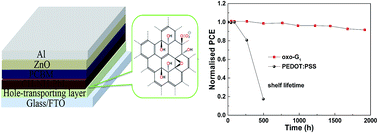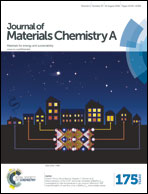Extending the environmental lifetime of unpackaged perovskite solar cells through interfacial design†
Abstract
Solution-processed oxo-functionalized graphene (oxo-G1) is employed to substitute hydrophilic PEDOT:PSS as an anode interfacial layer for perovskite solar cells. The resulting devices exhibit a reasonably high power conversion efficiency (PCE) of 15.2% in the planar inverted architecture with oxo-G1 as a hole transporting material (HTM), and most importantly, deploy the full open-circuit voltage (Voc) of up to 1.1 V. Moreover, oxo-G1 effectively slows down the ingress of water vapor into the device stack resulting in significantly enhanced environmental stability of unpackaged cells under illumination with 80% of the initial PCE being reached after 500 h. Without encapsulation, ∼60% of the initial PCE is retained after ∼1000 h of light soaking under 0.5 sun and ambient conditions maintaining the temperature beneath 30 °C. Moreover, the unsealed perovskite device retains 92% of its initial PCE after about 1900 h under ambient conditions and in the dark. Our results underpin that controlling water diffusion into perovskite cells through advanced interface engineering is a crucial step towards prolonged environmental stability.



 Please wait while we load your content...
Please wait while we load your content...